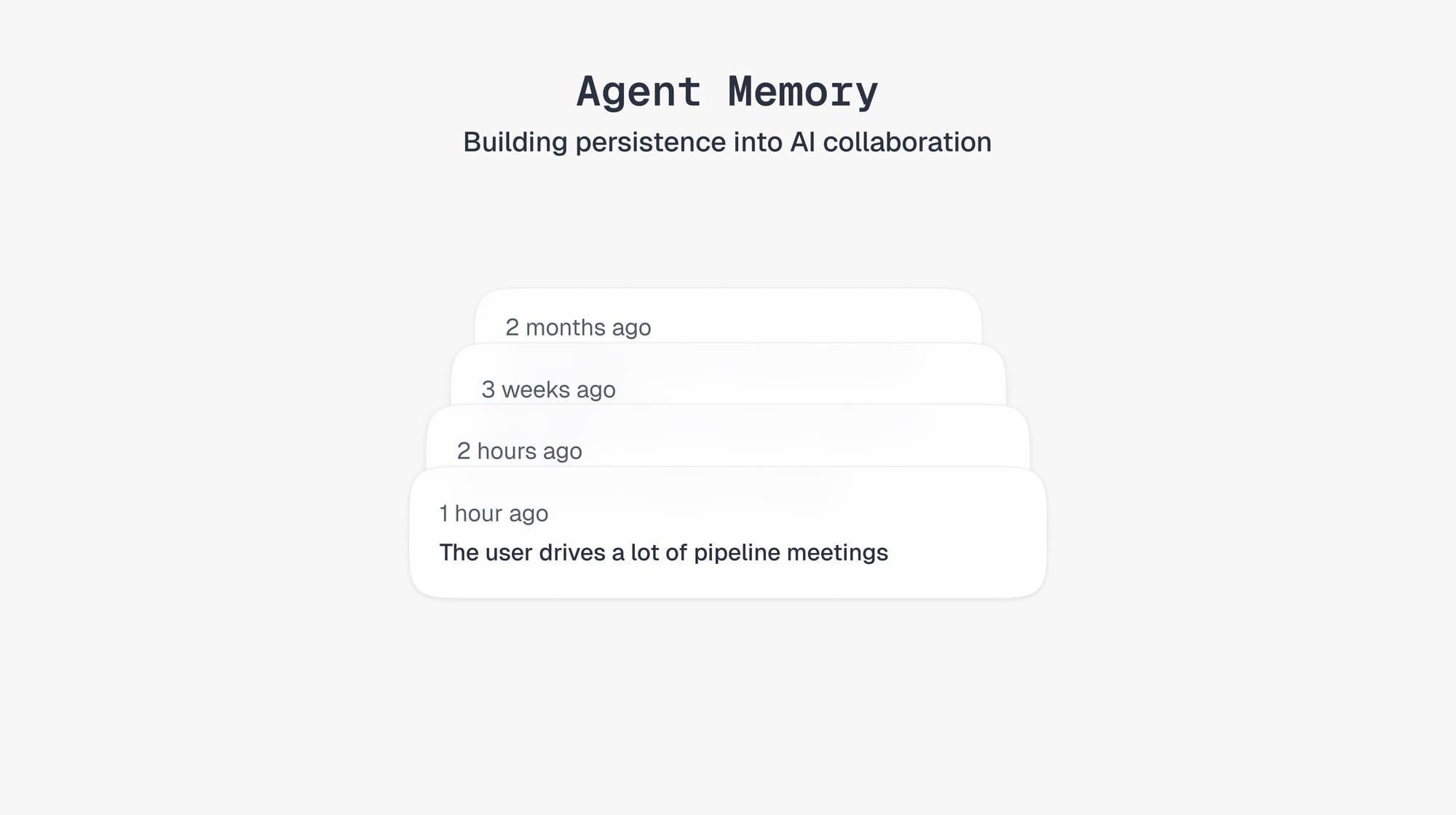Agent Memory: Building persistence into AI collaboration

When we built Dust, we solved a fundamental problem: AI agents that start from zero.
Custom agents with access to curated company knowledge meant every employee could create specialized AI that understood their context from day one.
Today, we're pushing this vision further with agent memory, transforming agents from knowledgeable to continuously learning.
From context to continuity
In traditional software, we've long understood the value of state management: applications remember preferences, maintain sessions, and build on interactions.
Dust custom agents with company data already transform productivity: your support agent knows documentation, your sales agent understands pricing, your engineering agent navigates codebases. But they reset between conversations. They don't remember yesterday's correction or learn preferences. Each interaction exists in a vacuum, creating friction where there should be fluid collaboration.
Agent memory removes this limitation. Now agents don't just access company knowledge, they evolve through use, building on every interaction to become more effective.
Introducing Agent Memory
Agent memory is a new tool that enables Dust agents to maintain user-specific context across conversations. When activated, agents build a persistent understanding of each user's work patterns, preferences, and ongoing projects.
The implementation is deliberately straightforward:
- User-scoped storage: Each person's interactions create their own knowledge graph
- Full transparency: All stored memories are inspectable in the agent details drawer
- Opt-in activation: Memory is added as a tool, not enabled by default
This design reflects a key insight: memory fundamentally transforms agent behavior. By making it opt-in, teams can thoughtfully decide where persistent context adds value versus where consistent, stateless behavior is preferred.
Why we built memory as a tool
During development, we discovered that memory isn't universally beneficial. Consider two scenarios:
1/ A code review agent without memory applies consistent standards across all pull requests. This ensures fair, unbiased reviews that maintain team-wide quality standards. The same agent with memory might begin adjusting its feedback based on individual developer patterns. This is useful for personalized coaching but potentially problematic for maintaining objective standards.
2/ A customer support agent with memory can provide continuity across interactions, remembering previous issues and preferences. But a compliance checking agent might need to evaluate each case independently, without bias from previous decisions.
This led us to implement memory as an optional tool rather than a default feature. Teams can enable it precisely where it creates value.
Real-world applications
Revenue Operations teams
Without memory: "Pull Q3 metrics for Acme Corp, they're the enterprise healthcare client with the three-year contract renewing in December."
With memory: "What's Acme's usage trend?" The agent knows they're an enterprise tier, their renewal timeline, and which metrics matter. It remembers pain points from previous conversations, competitive threats from QBRs, and expansion opportunities from success calls. Multi-month sales cycles maintain perfect continuity.
Product teams
Without memory: "Query the user_events table in the analytics database, columns are user_id, event_type, timestamp, metadata stored as JSON."
With memory: "Show me user engagement." The agent knows your schema, how tables join, and which fields contain PII. Correct it once about a calculation method, and it remembers forever. It learns naming conventions, query patterns, and performance optimizations. Your query assistant becomes a system expert.
How to add memory
Adding memory to an agent requires three steps:
- Open the agent configuration panel
- Add the Memory tool from available options
- Save the configuration
Behind this simplicity lies sophisticated infrastructure. Memory data is encrypted at rest, isolated per user, and never used for model training. The system maintains full audit trails while ensuring performance remains responsive even as memory accumulates over months of interactions.
Looking ahead
Memory is our first step toward self-improving agents. Today, it unlocks specific memory-centric use cases:
- task management agents that track commitments across conversations
- GTM agents that maintain deal context over months
- support agents that remember customer histories.
But the real potential lies in self-improvement. Agents with memory can track their own performance: which responses needed clarification, which patterns consistently work, where they repeatedly misunderstand requests. This creates the foundation for agents that don't just remember, they learn.
We envision agents that notice when multiple users correct the same behavior and proactively adjust. Agents that identify gaps in their knowledge and request additional context. Agents that evolve their own instructions based on what succeeds in practice.
Agent memory is now the foundational capability for building your company's ambient AI operating system. A system that evolves through daily use, where each interaction trains the system to be more effective. With it, Dust agents become the living memory of your company.
Agent memory is now available for all Dust workspaces. Learn more in our documentation or explore it directly in your agent configurations.

